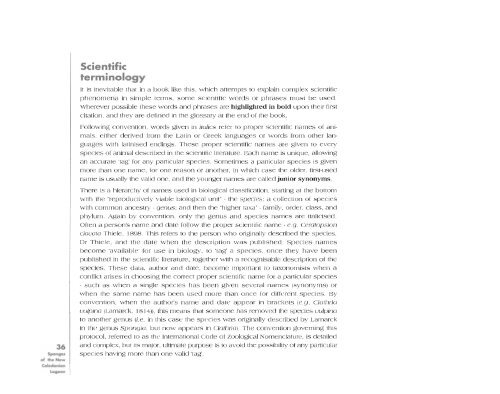Sponges of the New Caledonian lagoon - IRD
Sponges of the New Caledonian lagoon - IRD
Sponges of the New Caledonian lagoon - IRD
You also want an ePaper? Increase the reach of your titles
YUMPU automatically turns print PDFs into web optimized ePapers that Google loves.
36<br />
<strong>Sponges</strong><br />
<strong>of</strong> <strong>the</strong> <strong>New</strong><br />
<strong>Caledonian</strong><br />
Lagoon<br />
Scientific<br />
terminology<br />
It is inevitable that in a book like this, which attempts to explain complex scientific<br />
phenomena in simple terms, some scientific words or phrases must be used.<br />
Wherever possible <strong>the</strong>se words and phrases are highlighted in bold upon <strong>the</strong>ir first<br />
citation, and <strong>the</strong>y are defined in <strong>the</strong> glossary at <strong>the</strong> end <strong>of</strong> <strong>the</strong> book.<br />
Following convention, words given in italics refer to proper scientific names <strong>of</strong> ani<br />
mals, ei<strong>the</strong>r derived from <strong>the</strong> Latin or Greek languages or words from o<strong>the</strong>r lan<br />
guages with latinised endings. These proper scientific names are given to every<br />
species <strong>of</strong> animal described in <strong>the</strong> scientific literature. Each name is unique, allowing<br />
an accurate 'tag' for any particular species. Sometimes a particular species is given<br />
more than one name, for one reason or ano<strong>the</strong>r, in which case <strong>the</strong> older, first-used<br />
name is usually <strong>the</strong> valid one, and <strong>the</strong> younger names are called junior synonyms.<br />
There is a hierarchy <strong>of</strong> names used in biological classification, starting at <strong>the</strong> bottom<br />
with <strong>the</strong> "reproductively viable biological unit" - <strong>the</strong> species; a collection <strong>of</strong> species<br />
with common ancestry - genus; and <strong>the</strong>n <strong>the</strong> "higher taxa" - family, order, class, and<br />
phylum. Again by convention, only <strong>the</strong> genus and species names are italicised.<br />
Often a person's name and date follow <strong>the</strong> proper scientific name - e.g. Ceratopsion<br />
clauara Thiele, 1898. This refers to <strong>the</strong> person who originally described <strong>the</strong> species,<br />
Or Thiele, and <strong>the</strong> date when <strong>the</strong> description was published. Species names<br />
become 'available' for use in biology, to 'tag' a species, once <strong>the</strong>y have been<br />
published in <strong>the</strong> scientific literature, toge<strong>the</strong>r with a recognisable description <strong>of</strong> <strong>the</strong><br />
species. These data, author and date, become important to taxonomists when a<br />
conflict arises in choosing <strong>the</strong> correct proper scientific name for a particular species<br />
- such as when a single species has been given several names (synonyms) or<br />
when <strong>the</strong> same name has been used more than once for different species. By<br />
convention, when <strong>the</strong> author's name and date appear in brackets (e.g. Clathria<br />
uulpina (Lamarck, 1814)), this means that someone has removed <strong>the</strong> species uulpina<br />
to ano<strong>the</strong>r genus (i.e. in this case <strong>the</strong> species was originally described by Lamarck<br />
in th{' genus Spongia, but now appears in Clathria). The convention governing this<br />
protocol, referred to as <strong>the</strong> International Code <strong>of</strong> zoological Nomenclature, is detailed<br />
and complex, but its major, ultimate purpose is to avoid <strong>the</strong> possibility <strong>of</strong> any particular<br />
species having more than one valid 'tag'.

















